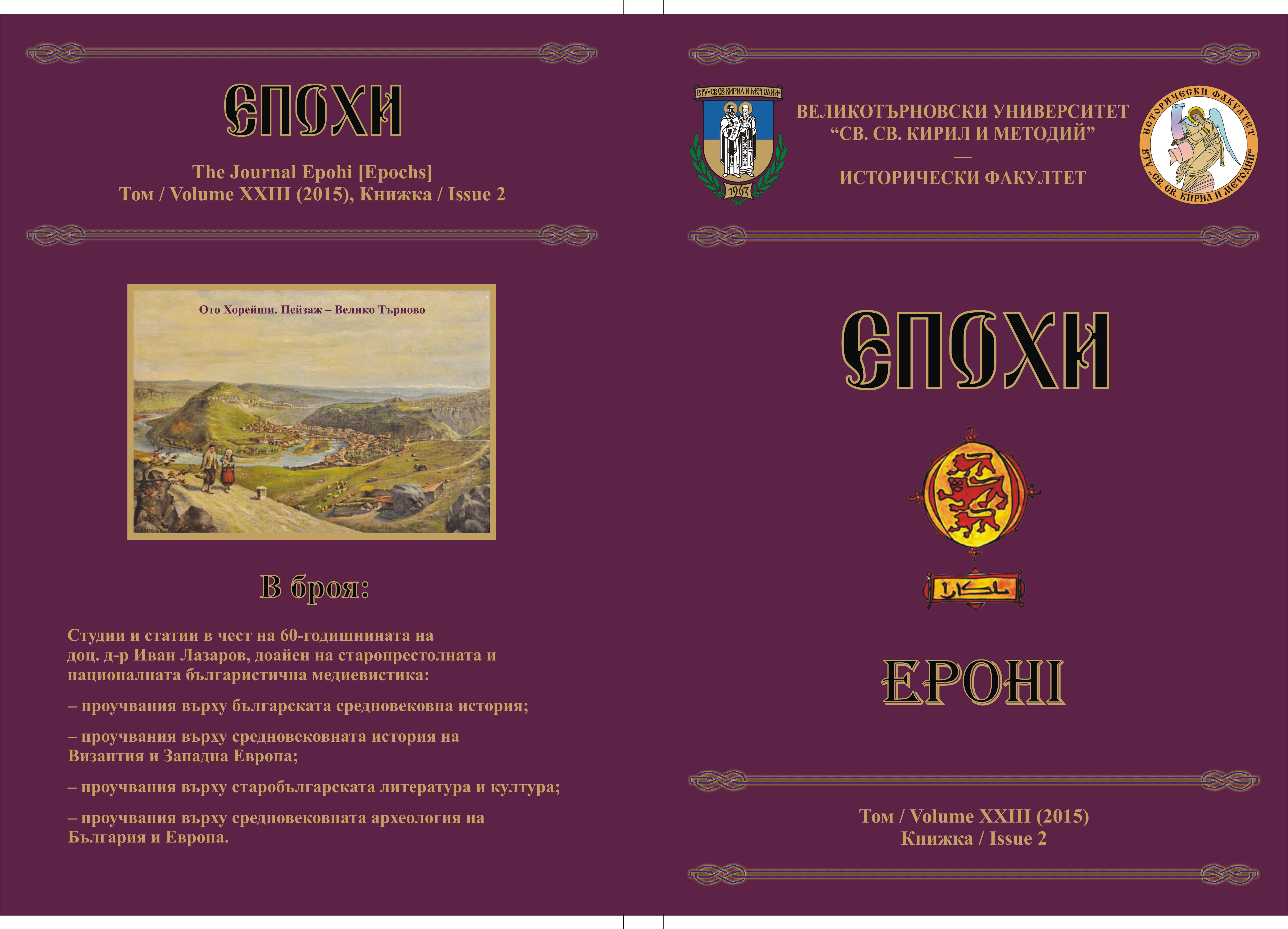Йерусалимия от църквата “Св. Георги” в Арбанаси
Jerusalem icon from the Church of St. George in Arbanasy
Author(s): Plamen SabevSubject(s): History, Cultural history, Diplomatic history, Economic history, Social history, Modern Age, 17th Century, 18th Century
Published by: Великотърновски университет „Св. св. Кирил и Методий”
Keywords: Arbanassi;temple of The Nativity of Christ;church of St. George;Bulgarian Revival; Jerusalem icon;inscriptions;chapel of the “St. Demetrius” church;iconography
Summary/Abstract: In 2011, I came across a Jerusalem type of icon in the chapel of the “St. Demetrius” church in Arbanasy. Due to the long-term exposure to humidity and dust, it needed an urgent restoration and conservation. However, in the museum data it was signed that the place of origin of the icon was the church of St. George in Arbanasy. After a research over older photographic documents, I’ve found that the icon was hang on the wall of the nave of this church, and eventually, due to the church’s closure for restoration, it was moved in the chapel of St. Demetrius church in the same village. After an urgent repair it was strengthened, cleaned and restored in the Regional museum of History – VelikoTarnovo. In spite of the urgent measures, the icon’s contents were inaccessible and not researched, which aroused my scientific interest. Up in the right corner, on the back, the Jerusalem icon is signed in Greek language, as follows: ΧΑ[ΔΖΙ]: NIKOΛAΥ TΟΥ ΔΗΜΗΤΡΙΥ ΑΠΟ ΤΗΝ ΜΕΓΑ ΤΡΝΟΒΑ ΑΡΒΑΝΤΟΧΌΡΙ. 1849. The painted side of the icon comprises inscriptions in Greek language with parallel additions of Bulgarian-language inscriptions. Each scene is presented not in chronological, but in compositional order. Four scenes in the upper register are from the Old Testament: Creation of Adam and Eve, The Fall, The Expel from the Paradise, Cain murders Abel. In the upper half of the front side is presented a multi-figural composition of the Last Judgment. In the middle, on a throne is seated Jesus, clad in archbishop vestments (as a Superior Bishop and a Judge, at the same time), flanked by the pleading Holy Virgin and St. John the Baptist, and the twelve apostles. In the scene’s both corners, traditionally are presented the two symbolical saints warriors – St. George and St. Demetrius, both on horsebacks. In the complicated iconographic scheme, traditionally as it could be seen in other examples is depicted a second register dedicated to the Holy Virgin. Her affectionate image is surrounded by 18 medallions with plots that are literally visualizing texts from the hymnography. In the centre of the icon is presented a large-scale map of the interior of the Jerusalem church “The Nativity of Christ” surrounded by golden walls. The composition itself is divided into three arcaded segments, which are depicting existing parts of The Hill of Golgotha, the Holy grave itself allocated under the altar of the church itself and the Resurrection of Jesus Christ. The rest of the composition, in the arcaded area is depicted Jesus Christ Almighty, holding a sphere with a golden cross – a symbol of the whole world taken by the Christianity. In the broad frame around His image are ordered 18 significant episodes: 1. Christ teaches in the Temple; 2. Healing of the Leper; 3. The Meeting with the Samaritan woman at the Well, 4. Healing of the Blind; 5.The Meeting with Zacchaeus up a tree; 6. The Ascension of Christ; 7. The Resurrection of Lazarus; 8. “Entry into Jerusalem; 9. The Last Supper; 10. The prayer in the Gethsemane garden; 11. Washing of the Feet of the Disciples; 12. The Betrayal of JudasIskariot; 13. Christ at the trial of Pilot of Pontius; 14. Peter’s Denial; 15. Apostle Peter’s repentance; 16. The Whipping of Christ; 17. Mocking of Christ; 18. Hanging on the Cross. After examining the icon and comparing it to other examples from monasteries and churches on the territory of Bulgaria, I can conclude that this type of iconography is popular and repetitive for the second half of the XIX century. In some of the examples we can read the names of Bulgarian icon-painters (or at least such that are working in Bulgarian language), carefully implemented and reflecting the icon-veneration in the years of the Ottoman domination. In regard to the style of the Jerusalem icon from Arbanasy – despite the naпve details – there is a tendency to precision and attention to the detail, a knowledge on the church hymnography, an affinity to the contrast colours and use of gold, without catchlights or complicated highlighting on the garments. In the context of the common stylistic forms of this type of church art during the mature period of the Bulgarian Revival, the researched icon is not an exception. In terms of artistry impressive is the complicated panoramic topography, the elegant result from the shrunk figures, the bilingual inscriptions, as well as the fact that the main theme is not omitted – the temple of The Nativity of Christ and the festive liturgy in it.
Journal: Епохи
- Issue Year: XXIII/2015
- Issue No: 2
- Page Range: 419-427
- Page Count: 9
- Language: Bulgarian

